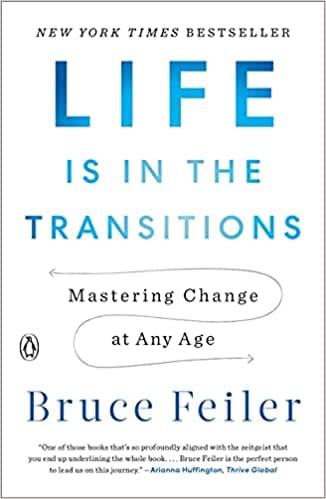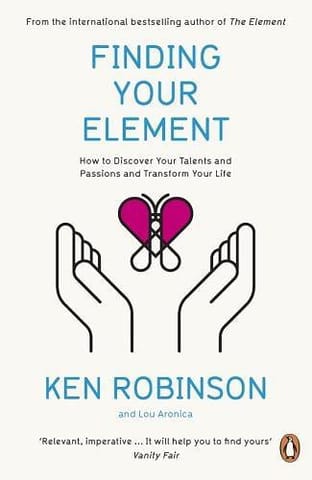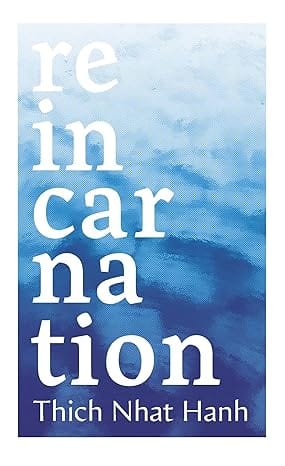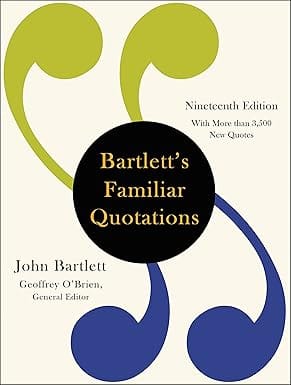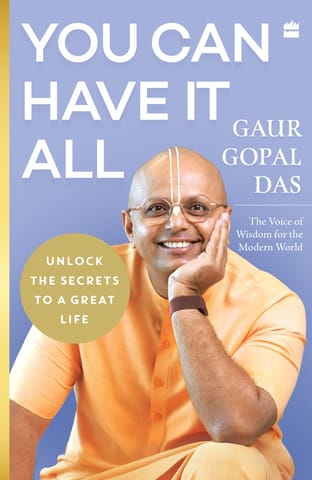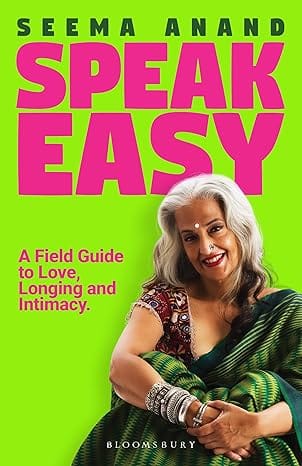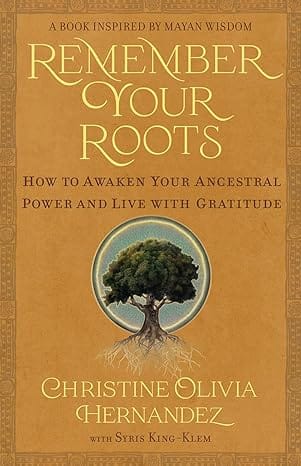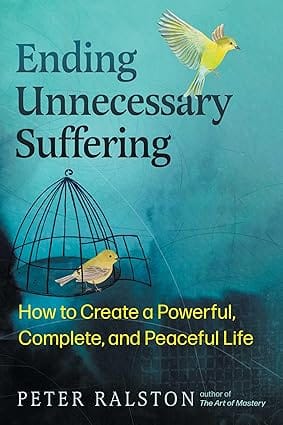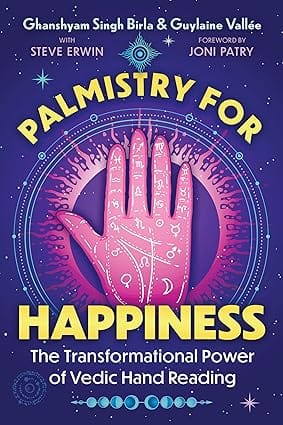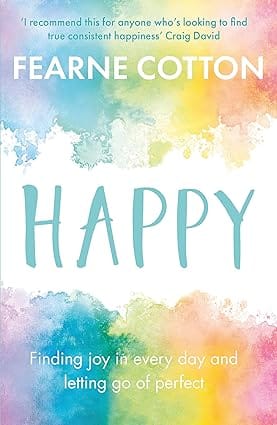- Non-ficton
- Non-ficton
- Contemporary Fiction
- Contemporary Fiction
- Children
- Children
- Comics & Graphic Novels
- Comics & Graphic Novels
- Non-Fiction
- Non-Fiction
- Fiction
- Fiction
A New York Times bestseller!
A pioneering and timely study of how to navigate life's biggest transitions with meaning, purpose, and skill
Bruce Feiler, author of the New York Times bestsellers The Secrets of Happy Families and Council of Dads, has long explored the stories that give our lives meaning. Galvanized by a personal crisis, he spent the last few years crisscrossing the country, collecting hundreds of life stories in all fifty states from Americans who’d been through major life changes—from losing jobs to losing loved ones; from changing careers to changing relationships; from getting sober to getting healthy to simply looking for a fresh start. He then spent a year coding these stories, identifying patterns and takeaways that can help all of us survive and thrive in times of change.
What Feiler discovered was a world in which transitions are becoming more plentiful and mastering the skills to manage them is more urgent for all of us. The idea that we’ll have one job, one relationship, one source of happiness is hopelessly outdated. We all feel unnerved by this upheaval. We’re concerned that our lives are not what we expected, that we’ve veered off course, living life out of order. But we’re not alone.
Life Is in the Transitions introduces the fresh, illuminating vision of the nonlinear life, in which each of us faces dozens of disruptors. One in ten of those becomes what Feiler calls a lifequake, a massive change that leads to a life transition. The average length of these transitions is five years. The upshot: We all spend half our lives in this unsettled state. You or someone you know is going through one now.
The most exciting thing Feiler identified is a powerful new tool kit for navigating these pivotal times. Drawing on his extraordinary trove of insights, he lays out specific strategies each of us can use to reimagine and rebuild our lives, often stronger than before.
From a master storyteller with an essential message, Life Is in the Transitions can move readers of any age to think deeply about times of change and how to transform them into periods of creativity and growth.
Review
“This is a remarkably poignant read about the pivotal moments in our lives. Bruce Feiler gets to the heart of how turning points shape us—and how we can shape them. The wisdom and stories in this book will change the way you tell your own story.” —Adam Grant, bestselling author of Originals and Give and Take
“Crammed with cutting-edge research and compelling real-world examples, Life Is in the Transitions provides a framework of striking originality that explodes with thought-provoking insights. It has profound implications for how we view and handle the transitions—voluntary and involuntary—that increasingly disrupt our lives. And it’s one of the rare books that is a pleasure to read in the moment and impossible to forget once you’ve finished the last page.” —Gretchen Rubin, bestselling author of The Happiness Project and The Four Tendencies
“I don’t know what’s more astonishing, the range of stories Bruce Feiler has found in asking people about their lives, or the wisdom he extracts from them. There is no more powerful reminder that the stories we inherit define success—and that definition constantly needs updating. This beautiful book is an indispensable guide to accepting change—as it really is, rather than what it’s supposed to be—and becoming who we really are.” —Charles Duhigg, author of bestsellers The Power of Habit and Smarter Faster Better
“Life Is in the Transitions is essential reading for anyone in the act of becoming—which is to say, all of us. Timely, wise and ultimately uplifting, the 15th book from Savannah native and self-described ‘lifestorian’ Bruce Feiler (The Council of Dads) offers an insightful, pragmatic toolkit for navigating the unexpected, uncertain and often upending disruptions of our lives, and for rewriting the next chapters in our ever-changing stories.” —Charleston Post & Courier
“[Feiler] offers in this insightful work timely suggestions for anyone adapting to significant life changes . . . He also presents evidence discrediting the notion of the midlife crisis and demonstrates that everyone’s life contains multiple significant ‘upheavals and uncertainties,’ which should thus be accepted as normal, contrary to conventional wisdom. The findings buttress practical suggestions for responding to major change, including identifying emotions, giving up old mindsets, testing alternatives, and seeking help from others. This logical, persuasive resource will resonate with any self-help reader.” —Publishers Weekly
“This highly recommended title couldn’t be more timely. . . . Feiler details a model for life transitions based on thousands of interviews with people from all walks of life and tells readers how to memorialize changes and give up old mind-sets. A helpful bonus is the complete outline for writing one’s own story or that of others.” —Library Journal
“An engaging consideration of how people navigate the highs and lows in their lives . . . [Feiler’s] relaxed, informal style is reassuring, and the numerous anecdotes gleaned from his wide variety of interview subjects keep the narrative fresh. His encouraging counsel will appeal to many.” —Booklist
“In Life Is in the Transitions, Bruce Feiler listens to, synthesizes, and helps make meaning of the American story at this complicated moment. With a big, open heart, he helps us all better understand our own stories, what it means to be human and how to navigate challenges and change. Along the way, he powerfully reminds us of the singular importance of honoring each other’s stories and lives through listening.” —Dave Isay, founder, Storycorps
"Bruce Feiler has a real knack for helping us see what is not obvious but is right in front of our eyes. In this clear, terrifically compelling book, full of instructive examples, he names and describes the ‘lifequake’ personal transitions that affect so many of us today and offers genuine wisdom, valuable counsel, and moving inspiration that make the journey easier. Read this book to open your eyes and lighten your heart!” —William Ury, co-author of Getting to Yes and author of Getting to Yes with Yourself
About the Author
Excerpt. © Reprinted by permission. All rights reserved.
The Life Story Project
What Happens When Our Fairy Tales Go Awry
I used to believe that phone calls don’t change your life, until one day I got a phone call that did. It was from my mother. “Your father is trying to kill himself.”
“He’s what?”
Suddenly she was talking and I wasn’t really following. Something about a bathroom, a razor, a desperate lunge for relief.
“Good God.”
“And that wasn’t the last time. Later he tried to climb out of a window while I was scrambling eggs.”
As a writer, I’m often asked whether I learned to write from my dad. The answer is no. My father was uncommonly friendly, even twinkling— we called him a professional Savannahian, for the seaside city in Georgia where he’d lived for eighty years—but he was more of a listener and a doer than a teller and a scribbler. A navy veteran, civic leader, Southern Demo- crat, he was never depressed a minute in his life.
Until he got Parkinson’s, a disease that affects your mobility—and your mood. My dad’s father, who also got the disease late in life, shot himself in the head a month before I graduated from high school. My father had promised for years he wouldn’t do the same. “I know the pain—and shame—it causes.”
Then he changed his mind—or at least that part of his mind he could still control. “I’ve lived a full life,” he said. “I don’t want to be mourned; I want to be celebrated.”
Six times in the next twelve weeks my father attempted to end his life. We tried every remedy imaginable, from counseling to electroconvulsive therapy. Yet we couldn’t surmount his core challenge: He had lost a reason to live.
My family, always a bit hyperfunctional, dove in. My older brother took over the family real estate business; my younger sister helped research medical treatments.
But I’m the narrative guy. For three decades, I had devoted my life to exploring the stories that give our lives meaning—from the tribal gather- ings of the ancient world to the chaotic family dinners of today. I have long been consumed by how stories connect and divide us on a societal level, how they define and deflate us on a personal level.
Given this interest, I began to wonder: If my dad was facing a narrative problem, at least in part, maybe it demanded a narrative solution. Maybe what my father needed was a spark to restart his life story.
One Monday morning I sat down and did the simplest, most restor- ative thing I could imagine.
I sent my dad a question.
What were your favorite toys as a child?
What happened next changed not only him, but everyone around him, and ultimately led me to reevaluate how we all achieve meaning, balance, and joy in our lives.
This is the story of what happened next, and what we all can learn from it.
This is the story of the Life Story Project.
The Story of your Life
Stop for a second and listen to the story going on in your head. It’s there, somewhere, in the background. It’s the story you tell others when you first meet them; it’s the story you tell yourself when you visit a meaningful place, when you flip through old photographs, when you celebrate an achievement, when you rush to the hospital. It’s the story of who you are, where you came from, where you dream of going in the future. It’s the high point of your life, the low point, the turning point. It’s what you believe in, what you fight for, what matters most to you. It’s the story of your life.
And that story isn’t just part of you. It is you in a fundamental way. Life is the story you tell yourself.
But how you tell that story—are you a hero, victim, lover, warrior, caretaker, believer—matters a great deal. How you adapt that story—how you revise, rethink, and rewrite your personal narrative as things change, lurch, or go wrong in your life—matters even more.
Recently, something happened to me that made me focus on these issues: I lost control of that story bouncing around in my head. For a while, I didn’t know who I was; I didn’t know where I was going.
I was lost.
That’s when I began to realize: While storytelling has drawn signifi- cant academic and popular interest in recent years, there’s an aspect of personal storytelling that hasn’t gotten enough attention. What happens when we misplace the plot of our lives? When we get sidetracked by one of the mishaps, foul-ups, or reversals of fortune that appear with uncomfort- able frequency these days?
What happens when our fairy tales go awry?
That’s what happened to my dad that fall, to me around that time, to all of us at one time or another.
We get stuck in the woods and can’t get out.
This time, though, I decided to do something about it. I set out to learn how to get unstuck.
How I Became a Lifestorian
What I did next—traveling around the country, gathering hundreds of life stories of everyday people, and then scouring those stories for themes and takeaways that could help all of us navigate the swerves in our lives—has a bit of a backstory.
I was born in Savannah, Georgia, to five generations of Southern Jews. That’s two storytelling traditions of outsiders that collided in me. I left the South and moved north for college, then left college and moved to Japan. There, in a town fifty miles and fifty years from Tokyo, I began writing letters home on crinkly airmail paper. You’re not going to believe what hap- pened to me today. When I got back home, everywhere I went, people said, “I loved your letters!”
“That’s great,” I said. “Have we met?”
Turns out my grandmother had xeroxed my letters and passed them around. They went viral the old-fashioned way. If so many people find these interesting, I should write a book, I thought. With some luck, I landed a book contract. More important, I’d found a calling. Stories were how I’d always found myself. How I put my unease and outsiderness into coherent form.
Over the next two decades, I wrote stories—books, articles, television—from six continents and seventy-five countries. I spent a year as a circus clown and another traveling with Garth Brooks. I retraced the greatest stories ever told, from Noah’s ark to the Exodus. I also got married and became the father to identical twin girls. Life was ascending.
Until I had a back-to-back-to-back set of experiences that shattered that linearity—and with it any illusion that I could control the narrative of my life.
First, I was diagnosed with a rare, aggressive bone cancer in my left leg. My disease was so nonlinear it was an adult-onset pediatric cancer. Frightened and face-to-face with death, I spent a brutal year enduring more than sixteen rounds of chemo and a seventeen-hour surgery to remove my femur, replace it with titanium, and relocate my fibula from my calf to my thigh. For two years I was on crutches; for a year after that I used a cane. Every step, every bite, every hug I’ve taken since has been haunted by the long tail of fear and fragility.
Then I nearly went bankrupt. The modest real estate business my father had built was gutted by the Great Recession. Three generations of dreams were dampened. I emptied my savings. At the same time, the internet decimated the world of print I had worked in for two decades. Friend after friend was out on the street. I woke up three nights a week in a pale sweat, staring at the ceiling, wondering.
Then came my father’s suicide spree. The conversations that fall were almost unhaveable, the language inadequate for the choices we faced. For me, though, there was something achingly familiar about this period. It drew me back to what had always been my default reaction to a crisis: When in turmoil, turn to narrative. The proper response to a setback is a story.
That notion had been gaining currency. A year earlier, while research- ing a book on high-functioning families, I had gone to the home of Marshall Duke, a psychologist at Emory University. Marshall and his colleague Robyn Fivush had been studying a phenomenon first noticed by Marshall’s wife, Sara. A teacher of students with special needs, Sara had observed that the children she worked with seemed better able to navigate their lives the more they knew about their family’s history. Marshall and Robyn devised a set of questions to test this thesis: Do you know where your grandparents met? Do you know an illness or injury your parents experienced when they were younger? Do you know what went on when you were being born? Children who scored highest on this test had a greater belief that they could control the world around them. It was the number one predictor of a child’s emotional well-being.
Why would knowing your family’s story help you navigate your own? “All family narratives take one of three shapes,” Marshall explained. First is the ascending family narrative: We came from nothing, we worked hard, we made it big. Next, the descending narrative: We used to have it all. Then we lost everything.
“The most healthful narrative,” he continued, “is the third one.” It’s called the oscillating family narrative. We’ve had ups and downs in our family. Your grandfather was vice president of the bank, but his house burned down. Your aunt was the first girl to go to college, but she got breast cancer. Children who know that lives take all different shapes are much better equipped to face life’s inevitable disruptions.
I was electrified by this research, and when I wrote about it in the New York Times, readers were, too. The article, “The Stories That Bind Us,” went viral in the modern sense of the word. I heard from parents, scholars, and leaders around the world. All attested to the same thing: Stories stitch us to one another, knit generation to generation, embolden us to take risks to improve our lives when things seem most unhopeful.
Facing one of those unhopeful moments myself that fall, this idea gave me hope. What if I ask my dad to tell his story? Not too long, I thought; just a page or two. The first question I sent—about his childhood toys—worked, so I followed with another. Are you still friends with any of your friends from high school? Then: What was your house like as a child? As he gained confi- dence, I started emailing him questions every Monday morning. How’d you become an Eagle Scout? How’d you join the navy? How’d you meet Mom?
My father couldn’t move his fingers at this point, so he couldn’t type. He would think about the question all week, dictate his story to Siri, then print out a draft and edit it. A lifelong collector, he began adding photographs, newspaper clippings, love letters to my mom. As his writing grew bolder, I made the questions more probing. What’s your biggest regret?
How’d you survive your first downturn? The process continued for the next four years, until my father, a man who had never written anything longer than a memo, backed into writing an autobiography. It was the most remarkable transformation any of us in the family had ever seen.
But what exactly explained this transformation? To learn more, I plunged into the neuroscience and biochemistry of storytelling; I inter- viewed experts on the psychological and emotional benefits of life reminis- cence; I tracked down pioneers in the nascent disciplines of narrative gerontology, narrative adolescence, and narrative medicine. What I found was a young-but-growing field built around the idea that reimagining and reconstructing our personal stories is vital to living a fulfilling life.
But I also found something lacking. There was an aspect of what my dad was going through, what I was going through, what nearly everyone I knew was going through that seemed left out of the conversation. That missing ingredient touched on what Marshall had identified as the key ele- ment of family stories: their shape.
Our personal narratives, I began to think, have shapes as much as our family ones do. Each of us carries around an unspoken set of assumptions that dictate how we expect our lives will unfold. These expectations come from all corners and influence us more than we admit. We’ve been led to believe that our lives will always ascend, for example, and are shocked to discover they oscillate instead. Our society tells us we should be basking in progress, but our experience tells us we are beset by slip-ups. Might this gap help explain the anxiety so many of us feel?
All these issues came to a head for me one unlikely day. The occasion was my thirtieth college reunion. I had thrown out my back, and my classmate David offered to drive us from Brooklyn, where we both live. We’ll have a chance to catch up, I thought. But David turned out to be closing a multimillion-dollar real estate deal and spent the entire car ride toggling between phone calls with ebullient lawyers on the one hand and distraught colleagues on the other. The day before, the nine-month-old baby of one of David’s business partners had gone down for a nap and never woke up. David was both on top of the world and completely flattened. I was moderating a panel of prominent classmates that afternoon. In preparation I had assembled their résumés, all neatly typed and impres- sive. But I was so shaken by the story David had shared that by the time I took the stage, I looked out at the auditorium full of people, took the résumés, and ripped them in half. “I don’t care about your successes,” I said. “Tell them to your mother. I want to hear about your struggles, your challenges, what keeps you awake at night.”
That evening, the class of ’87 gathered under a massive tent. There was a bar on one end and a barbecue on the other. It took me two hours to walk from one end to the other as classmate after classmate came up and poured out their own heartbreaking stories.
My wife went into the hospital with a routine headache and died the next morning.
My thirteen-year-old slashed her wrists. My mother’s an alcoholic.
My boss is a crook.
I’m being sued for malpractice. I’m being treated for depression. I’m afraid.
What everybody said, in one way or the other, was the same thing: My life has been disrupted, my dreams shattered, my confidence punctured. There’s a gap between the upward, dependable, “every problem can be cured with a pill, an app, or five minutes of meditation” life I was sold, and the unstable, unpredictable, utterly fluid life I’m forced to contend with.
The life I’m living is not the life I expected.
I’m living life out of order.
That night I called my wife. “Something’s going on. No one knows how to tell their story anymore. I’ve got to figure out how to help.”
Life Is in the Transitions: Mastering Change at Any Age
SIZE GUIDE
- ISBN: 9781101980514
- Author: Bruce Feiler
- Publisher: Penguin Books
- Pages: 368
- Format: Paperback
Book Description
A New York Times bestseller!
A pioneering and timely study of how to navigate life's biggest transitions with meaning, purpose, and skill
Bruce Feiler, author of the New York Times bestsellers The Secrets of Happy Families and Council of Dads, has long explored the stories that give our lives meaning. Galvanized by a personal crisis, he spent the last few years crisscrossing the country, collecting hundreds of life stories in all fifty states from Americans who’d been through major life changes—from losing jobs to losing loved ones; from changing careers to changing relationships; from getting sober to getting healthy to simply looking for a fresh start. He then spent a year coding these stories, identifying patterns and takeaways that can help all of us survive and thrive in times of change.
What Feiler discovered was a world in which transitions are becoming more plentiful and mastering the skills to manage them is more urgent for all of us. The idea that we’ll have one job, one relationship, one source of happiness is hopelessly outdated. We all feel unnerved by this upheaval. We’re concerned that our lives are not what we expected, that we’ve veered off course, living life out of order. But we’re not alone.
Life Is in the Transitions introduces the fresh, illuminating vision of the nonlinear life, in which each of us faces dozens of disruptors. One in ten of those becomes what Feiler calls a lifequake, a massive change that leads to a life transition. The average length of these transitions is five years. The upshot: We all spend half our lives in this unsettled state. You or someone you know is going through one now.
The most exciting thing Feiler identified is a powerful new tool kit for navigating these pivotal times. Drawing on his extraordinary trove of insights, he lays out specific strategies each of us can use to reimagine and rebuild our lives, often stronger than before.
From a master storyteller with an essential message, Life Is in the Transitions can move readers of any age to think deeply about times of change and how to transform them into periods of creativity and growth.
Review
“This is a remarkably poignant read about the pivotal moments in our lives. Bruce Feiler gets to the heart of how turning points shape us—and how we can shape them. The wisdom and stories in this book will change the way you tell your own story.” —Adam Grant, bestselling author of Originals and Give and Take
“Crammed with cutting-edge research and compelling real-world examples, Life Is in the Transitions provides a framework of striking originality that explodes with thought-provoking insights. It has profound implications for how we view and handle the transitions—voluntary and involuntary—that increasingly disrupt our lives. And it’s one of the rare books that is a pleasure to read in the moment and impossible to forget once you’ve finished the last page.” —Gretchen Rubin, bestselling author of The Happiness Project and The Four Tendencies
“I don’t know what’s more astonishing, the range of stories Bruce Feiler has found in asking people about their lives, or the wisdom he extracts from them. There is no more powerful reminder that the stories we inherit define success—and that definition constantly needs updating. This beautiful book is an indispensable guide to accepting change—as it really is, rather than what it’s supposed to be—and becoming who we really are.” —Charles Duhigg, author of bestsellers The Power of Habit and Smarter Faster Better
“Life Is in the Transitions is essential reading for anyone in the act of becoming—which is to say, all of us. Timely, wise and ultimately uplifting, the 15th book from Savannah native and self-described ‘lifestorian’ Bruce Feiler (The Council of Dads) offers an insightful, pragmatic toolkit for navigating the unexpected, uncertain and often upending disruptions of our lives, and for rewriting the next chapters in our ever-changing stories.” —Charleston Post & Courier
“[Feiler] offers in this insightful work timely suggestions for anyone adapting to significant life changes . . . He also presents evidence discrediting the notion of the midlife crisis and demonstrates that everyone’s life contains multiple significant ‘upheavals and uncertainties,’ which should thus be accepted as normal, contrary to conventional wisdom. The findings buttress practical suggestions for responding to major change, including identifying emotions, giving up old mindsets, testing alternatives, and seeking help from others. This logical, persuasive resource will resonate with any self-help reader.” —Publishers Weekly
“This highly recommended title couldn’t be more timely. . . . Feiler details a model for life transitions based on thousands of interviews with people from all walks of life and tells readers how to memorialize changes and give up old mind-sets. A helpful bonus is the complete outline for writing one’s own story or that of others.” —Library Journal
“An engaging consideration of how people navigate the highs and lows in their lives . . . [Feiler’s] relaxed, informal style is reassuring, and the numerous anecdotes gleaned from his wide variety of interview subjects keep the narrative fresh. His encouraging counsel will appeal to many.” —Booklist
“In Life Is in the Transitions, Bruce Feiler listens to, synthesizes, and helps make meaning of the American story at this complicated moment. With a big, open heart, he helps us all better understand our own stories, what it means to be human and how to navigate challenges and change. Along the way, he powerfully reminds us of the singular importance of honoring each other’s stories and lives through listening.” —Dave Isay, founder, Storycorps
"Bruce Feiler has a real knack for helping us see what is not obvious but is right in front of our eyes. In this clear, terrifically compelling book, full of instructive examples, he names and describes the ‘lifequake’ personal transitions that affect so many of us today and offers genuine wisdom, valuable counsel, and moving inspiration that make the journey easier. Read this book to open your eyes and lighten your heart!” —William Ury, co-author of Getting to Yes and author of Getting to Yes with Yourself
About the Author
Excerpt. © Reprinted by permission. All rights reserved.
The Life Story Project
What Happens When Our Fairy Tales Go Awry
I used to believe that phone calls don’t change your life, until one day I got a phone call that did. It was from my mother. “Your father is trying to kill himself.”
“He’s what?”
Suddenly she was talking and I wasn’t really following. Something about a bathroom, a razor, a desperate lunge for relief.
“Good God.”
“And that wasn’t the last time. Later he tried to climb out of a window while I was scrambling eggs.”
As a writer, I’m often asked whether I learned to write from my dad. The answer is no. My father was uncommonly friendly, even twinkling— we called him a professional Savannahian, for the seaside city in Georgia where he’d lived for eighty years—but he was more of a listener and a doer than a teller and a scribbler. A navy veteran, civic leader, Southern Demo- crat, he was never depressed a minute in his life.
Until he got Parkinson’s, a disease that affects your mobility—and your mood. My dad’s father, who also got the disease late in life, shot himself in the head a month before I graduated from high school. My father had promised for years he wouldn’t do the same. “I know the pain—and shame—it causes.”
Then he changed his mind—or at least that part of his mind he could still control. “I’ve lived a full life,” he said. “I don’t want to be mourned; I want to be celebrated.”
Six times in the next twelve weeks my father attempted to end his life. We tried every remedy imaginable, from counseling to electroconvulsive therapy. Yet we couldn’t surmount his core challenge: He had lost a reason to live.
My family, always a bit hyperfunctional, dove in. My older brother took over the family real estate business; my younger sister helped research medical treatments.
But I’m the narrative guy. For three decades, I had devoted my life to exploring the stories that give our lives meaning—from the tribal gather- ings of the ancient world to the chaotic family dinners of today. I have long been consumed by how stories connect and divide us on a societal level, how they define and deflate us on a personal level.
Given this interest, I began to wonder: If my dad was facing a narrative problem, at least in part, maybe it demanded a narrative solution. Maybe what my father needed was a spark to restart his life story.
One Monday morning I sat down and did the simplest, most restor- ative thing I could imagine.
I sent my dad a question.
What were your favorite toys as a child?
What happened next changed not only him, but everyone around him, and ultimately led me to reevaluate how we all achieve meaning, balance, and joy in our lives.
This is the story of what happened next, and what we all can learn from it.
This is the story of the Life Story Project.
The Story of your Life
Stop for a second and listen to the story going on in your head. It’s there, somewhere, in the background. It’s the story you tell others when you first meet them; it’s the story you tell yourself when you visit a meaningful place, when you flip through old photographs, when you celebrate an achievement, when you rush to the hospital. It’s the story of who you are, where you came from, where you dream of going in the future. It’s the high point of your life, the low point, the turning point. It’s what you believe in, what you fight for, what matters most to you. It’s the story of your life.
And that story isn’t just part of you. It is you in a fundamental way. Life is the story you tell yourself.
But how you tell that story—are you a hero, victim, lover, warrior, caretaker, believer—matters a great deal. How you adapt that story—how you revise, rethink, and rewrite your personal narrative as things change, lurch, or go wrong in your life—matters even more.
Recently, something happened to me that made me focus on these issues: I lost control of that story bouncing around in my head. For a while, I didn’t know who I was; I didn’t know where I was going.
I was lost.
That’s when I began to realize: While storytelling has drawn signifi- cant academic and popular interest in recent years, there’s an aspect of personal storytelling that hasn’t gotten enough attention. What happens when we misplace the plot of our lives? When we get sidetracked by one of the mishaps, foul-ups, or reversals of fortune that appear with uncomfort- able frequency these days?
What happens when our fairy tales go awry?
That’s what happened to my dad that fall, to me around that time, to all of us at one time or another.
We get stuck in the woods and can’t get out.
This time, though, I decided to do something about it. I set out to learn how to get unstuck.
How I Became a Lifestorian
What I did next—traveling around the country, gathering hundreds of life stories of everyday people, and then scouring those stories for themes and takeaways that could help all of us navigate the swerves in our lives—has a bit of a backstory.
I was born in Savannah, Georgia, to five generations of Southern Jews. That’s two storytelling traditions of outsiders that collided in me. I left the South and moved north for college, then left college and moved to Japan. There, in a town fifty miles and fifty years from Tokyo, I began writing letters home on crinkly airmail paper. You’re not going to believe what hap- pened to me today. When I got back home, everywhere I went, people said, “I loved your letters!”
“That’s great,” I said. “Have we met?”
Turns out my grandmother had xeroxed my letters and passed them around. They went viral the old-fashioned way. If so many people find these interesting, I should write a book, I thought. With some luck, I landed a book contract. More important, I’d found a calling. Stories were how I’d always found myself. How I put my unease and outsiderness into coherent form.
Over the next two decades, I wrote stories—books, articles, television—from six continents and seventy-five countries. I spent a year as a circus clown and another traveling with Garth Brooks. I retraced the greatest stories ever told, from Noah’s ark to the Exodus. I also got married and became the father to identical twin girls. Life was ascending.
Until I had a back-to-back-to-back set of experiences that shattered that linearity—and with it any illusion that I could control the narrative of my life.
First, I was diagnosed with a rare, aggressive bone cancer in my left leg. My disease was so nonlinear it was an adult-onset pediatric cancer. Frightened and face-to-face with death, I spent a brutal year enduring more than sixteen rounds of chemo and a seventeen-hour surgery to remove my femur, replace it with titanium, and relocate my fibula from my calf to my thigh. For two years I was on crutches; for a year after that I used a cane. Every step, every bite, every hug I’ve taken since has been haunted by the long tail of fear and fragility.
Then I nearly went bankrupt. The modest real estate business my father had built was gutted by the Great Recession. Three generations of dreams were dampened. I emptied my savings. At the same time, the internet decimated the world of print I had worked in for two decades. Friend after friend was out on the street. I woke up three nights a week in a pale sweat, staring at the ceiling, wondering.
Then came my father’s suicide spree. The conversations that fall were almost unhaveable, the language inadequate for the choices we faced. For me, though, there was something achingly familiar about this period. It drew me back to what had always been my default reaction to a crisis: When in turmoil, turn to narrative. The proper response to a setback is a story.
That notion had been gaining currency. A year earlier, while research- ing a book on high-functioning families, I had gone to the home of Marshall Duke, a psychologist at Emory University. Marshall and his colleague Robyn Fivush had been studying a phenomenon first noticed by Marshall’s wife, Sara. A teacher of students with special needs, Sara had observed that the children she worked with seemed better able to navigate their lives the more they knew about their family’s history. Marshall and Robyn devised a set of questions to test this thesis: Do you know where your grandparents met? Do you know an illness or injury your parents experienced when they were younger? Do you know what went on when you were being born? Children who scored highest on this test had a greater belief that they could control the world around them. It was the number one predictor of a child’s emotional well-being.
Why would knowing your family’s story help you navigate your own? “All family narratives take one of three shapes,” Marshall explained. First is the ascending family narrative: We came from nothing, we worked hard, we made it big. Next, the descending narrative: We used to have it all. Then we lost everything.
“The most healthful narrative,” he continued, “is the third one.” It’s called the oscillating family narrative. We’ve had ups and downs in our family. Your grandfather was vice president of the bank, but his house burned down. Your aunt was the first girl to go to college, but she got breast cancer. Children who know that lives take all different shapes are much better equipped to face life’s inevitable disruptions.
I was electrified by this research, and when I wrote about it in the New York Times, readers were, too. The article, “The Stories That Bind Us,” went viral in the modern sense of the word. I heard from parents, scholars, and leaders around the world. All attested to the same thing: Stories stitch us to one another, knit generation to generation, embolden us to take risks to improve our lives when things seem most unhopeful.
Facing one of those unhopeful moments myself that fall, this idea gave me hope. What if I ask my dad to tell his story? Not too long, I thought; just a page or two. The first question I sent—about his childhood toys—worked, so I followed with another. Are you still friends with any of your friends from high school? Then: What was your house like as a child? As he gained confi- dence, I started emailing him questions every Monday morning. How’d you become an Eagle Scout? How’d you join the navy? How’d you meet Mom?
My father couldn’t move his fingers at this point, so he couldn’t type. He would think about the question all week, dictate his story to Siri, then print out a draft and edit it. A lifelong collector, he began adding photographs, newspaper clippings, love letters to my mom. As his writing grew bolder, I made the questions more probing. What’s your biggest regret?
How’d you survive your first downturn? The process continued for the next four years, until my father, a man who had never written anything longer than a memo, backed into writing an autobiography. It was the most remarkable transformation any of us in the family had ever seen.
But what exactly explained this transformation? To learn more, I plunged into the neuroscience and biochemistry of storytelling; I inter- viewed experts on the psychological and emotional benefits of life reminis- cence; I tracked down pioneers in the nascent disciplines of narrative gerontology, narrative adolescence, and narrative medicine. What I found was a young-but-growing field built around the idea that reimagining and reconstructing our personal stories is vital to living a fulfilling life.
But I also found something lacking. There was an aspect of what my dad was going through, what I was going through, what nearly everyone I knew was going through that seemed left out of the conversation. That missing ingredient touched on what Marshall had identified as the key ele- ment of family stories: their shape.
Our personal narratives, I began to think, have shapes as much as our family ones do. Each of us carries around an unspoken set of assumptions that dictate how we expect our lives will unfold. These expectations come from all corners and influence us more than we admit. We’ve been led to believe that our lives will always ascend, for example, and are shocked to discover they oscillate instead. Our society tells us we should be basking in progress, but our experience tells us we are beset by slip-ups. Might this gap help explain the anxiety so many of us feel?
All these issues came to a head for me one unlikely day. The occasion was my thirtieth college reunion. I had thrown out my back, and my classmate David offered to drive us from Brooklyn, where we both live. We’ll have a chance to catch up, I thought. But David turned out to be closing a multimillion-dollar real estate deal and spent the entire car ride toggling between phone calls with ebullient lawyers on the one hand and distraught colleagues on the other. The day before, the nine-month-old baby of one of David’s business partners had gone down for a nap and never woke up. David was both on top of the world and completely flattened. I was moderating a panel of prominent classmates that afternoon. In preparation I had assembled their résumés, all neatly typed and impres- sive. But I was so shaken by the story David had shared that by the time I took the stage, I looked out at the auditorium full of people, took the résumés, and ripped them in half. “I don’t care about your successes,” I said. “Tell them to your mother. I want to hear about your struggles, your challenges, what keeps you awake at night.”
That evening, the class of ’87 gathered under a massive tent. There was a bar on one end and a barbecue on the other. It took me two hours to walk from one end to the other as classmate after classmate came up and poured out their own heartbreaking stories.
My wife went into the hospital with a routine headache and died the next morning.
My thirteen-year-old slashed her wrists. My mother’s an alcoholic.
My boss is a crook.
I’m being sued for malpractice. I’m being treated for depression. I’m afraid.
What everybody said, in one way or the other, was the same thing: My life has been disrupted, my dreams shattered, my confidence punctured. There’s a gap between the upward, dependable, “every problem can be cured with a pill, an app, or five minutes of meditation” life I was sold, and the unstable, unpredictable, utterly fluid life I’m forced to contend with.
The life I’m living is not the life I expected.
I’m living life out of order.
That night I called my wife. “Something’s going on. No one knows how to tell their story anymore. I’ve got to figure out how to help.”
User reviews
NEWSLETTER
Subscribe to get Email Updates!
Thanks for subscribing.
Your response has been recorded.

India's Iconic & Independent Book Store offering a vast selection of books across a variety of genres Since 1978.
"We Believe In The Power of Books" Our mission is to make books accessible to everyone, and to cultivate a culture of reading and learning. We strive to provide a wide range of books, from classic literature, sci-fi and fantasy, to graphic novels, biographies and self-help books, so that everyone can find something to read.
Whether you’re looking for your next great read, a gift for someone special, or just browsing, Midland is here to make your book-buying experience easy and enjoyable.
We are shipping pan India and across the world.
For Bulk Order / Corporate Gifting
 +91 9818282497 |
+91 9818282497 |  [email protected]
[email protected]
Click To Know More
INFORMATION
QUICK LINKS
ADDRESS
Shop No.20, Aurobindo Palace Market, Near Church, New Delhi

